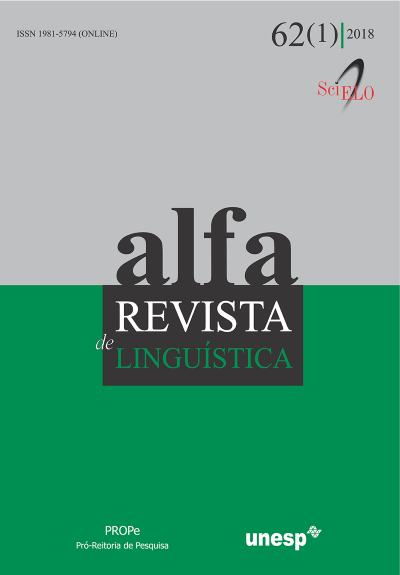The acquisition of pre-tonic vowels in Brazilian Portuguese
DOI:
https://doi.org/10.1590/1981-5794-1804-9Keywords:
Phonological acquisition, Phonological contrast, Pretonic vowel,Abstract
This article discusses the acquisition of the pretonic vowels in Brazilian Portuguese, by 3 monolingual children acquiring the paulista dialect, aged between 1;4 and 3;5, and its relation to the acquisition of stressed vowels. Based on Miranda (2013), we start out from the supposition that the acquisition of pretonic vowels is subject to the instability of this position, and segments affected by phonological processes take longer to be acquired. The children’s productions show that the high pretonic vowels are acquired in contrast with the mid vowels, (/i,o/ and /e,u/), and that the pretonic /o/ is acquired before /e/. We analyse these results based on the Contrastive Hierarchy Theory (Dresher 2009), according to which the lexical representation of segments is specific to each language and only contrastive and active feature must be present in the representation. We propose that the acquisition of pretonic vowels follows the Maximum Contrast Principle: because of the instability found in this position, segments must be maximally contrastive, that is, they must contrast in place and height. The pretonic /e/, being more unstable (cf. Callou, Morais and Leite (2002), Viegas (2001) and Yacovenco (1993)), is the last one to be acquired, bringing with it the pretonic /u/.Downloads
Download data is not yet available.
Downloads
Published
25/04/2018
How to Cite
BOHN, G. P.; SANTOS, R. S. The acquisition of pre-tonic vowels in Brazilian Portuguese. ALFA: Revista de Linguística, São Paulo, v. 62, n. 1, 2018. DOI: 10.1590/1981-5794-1804-9. Disponível em: https://periodicos.fclar.unesp.br/alfa/article/view/9646. Acesso em: 7 dec. 2025.
Issue
Section
Papers
License
Manuscripts accepted for publication and published are property of Alfa: Revista de Linguística. It is forbidden the full or partial submission of the manuscript to any other journal. Authors are solely responsible for the article's content. Translation into another language without written permission from the Editor advised by the Editorial Board is prohibited.

